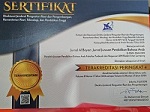The Influence of Flashcard on Arabic Learning Outcomes of Shorof Subject for Junior High School Students
Abstract
Keywords
Full Text:
PDFReferences
Ady Fauzan, Dihin Muriyatmoko, and Shoffin Nahwa Utama. “Penerapan Teknologi Augmented Reality pada Media Pembelajaran Bahasa Arab: Durus Al-Lughah Jilid 1.” ELSE (Elementary School Education Journal) 4, no. 1 (2020).
Astuti, Indah Puji. Aplikasi Tashrif Istilahi pada Ilmu Sharaf dengan Menggunakan Stemmer Berbasis Web. Skripsi: UIN Syarif Hidayatullah 2011.
Asy’ari, Hasyim. “Keistimewaan Bahasa Arab Sebagai Bahasa Al- Qur'an.” Nidhomul Haq 1, no. 1 (2016): 21–28.
Bidari, Bidari. “Analisis Tes Bahasa Arab pada Kitab Durusullughah Juz II Karya KH Imam Zarkasyi dan KH Imam Subani.” Maharot: Journal of Islamic Education 2, no. 2 (2018): 71-92.
Cavazos Vela, Javier, Ikonomopoulos, J., Salinas, C., and Zamora, E. “Using Quantitative Research Designs to Conduct Outcome-Based Research with Children and Adolescents.” Journal of Child and Adolescent Counseling 9, no. 2 (2023): 149–169.
Creswell, John W. Educational Research Planning, Conducting and Evaluating Quantitative and Qualitative Research. Boston: Pearson Education, 2012.
Gerbing, David W. "Campbell and Stanley for Undergraduates". Experimental and Quasi-Experimental Designs for Research. Houghton Mifflin Company 29, (1984).
Dwyer, Carol Anne. “Assessment and Classroom Learning: Theory and Practice.” Assessment in Education: Principles, Policy & Practice 5, no. 1 (1998): 131-137.
Nahartyo, E. Desain dan Implementasi Riset Eksperimen. Yogyakarta: UPP STIM YKPN, 2013.
Gay, Lorraine R, Geoffrey E. Mills and Peter Airasian. Educational Research, Competencies for Analysis and Application. New Jersey: Pearson Education, 2009.
Syahid, Noor, Agus Budiman, Ihwan Mahmudi, dkk. Petunjuk Teknis Penulisan Skripsi Fakultas Tarbiyah. Cetakan ke. Ponorogo: UNIDA Gontor Press, 2021.
Hanisah. Efektivitas Penggunaan Media Kartu Bergambar (Flash Card) Terhadap Pengenalan Kosakata Bahasa Arab pada Peserta Didik Kelas VII SMP Muhammadiyah Parepare. Skripsi: UIN Alauddin Makassar, 2016.
Mohajan, Haradhan Kumar. “Quantitative Research: A Successful Investigation in Natural and Social Sciences.” Journal of Economic Development, Environment, and People 9, no. 4 (2020): 50–79.
Helmanto, Fachri. “Flashcard: Belajar Mufrodat Bahasa Arab Semakin Menantang.” Tatsqifiy: Jurnal Pendidikan Bahasa Arab 1, no. 2 (2020): 141-151.
Fitriani. Henni, Riska Imanda, Ayu Rahmi and Siti Nurmalinda. “The Development of Flashcard Learning Media Based on Make a Match on Colloid.” International Journal for Educational and Vocational Studies 3, no. 5 (2021): 373-379.
Hermawan, Acep. Metodologi Pembelajaran Bahasa Arab. Bandung: PT. Remaja Rosdakarya, 2011.
Istiharoh, Mirsa and Setyabudi Indartono. “Learning Innovation for Character Education in Global Era: Methods and Assessments.” ICoSS CE 323, (2019): 272-279.
Siko, Jason P. and Michael Barbour. “Homemade PowerPoint Games: Game Design Pedagogy Aligned to The TPACK Framework.” Computers in the Schools 29, no. 4 (2012): 339-354.
Pulungan, Enny Nazrah, and Rizki Hariati. “Developing the Educational Game Tool to Improve Reading Ability of Early Childhood.” IJoLE: International Journal of Language Education 6, no. 2 (2022): 25-35.
Gay, Lorraine R., Geoffrey E. Mills, and Peter Airasian. Educational Research Competencies for Analysis and Application. New Jersey: Pearson Education, 2012.
Tallaksen, Lena M., and Gregor Laaha. “Frequency Analysis.” Hydrological Drought Elsevier (2023): 233-304.
Nafi, Weldan. "Ilmu Pertukaran: Asal-usul dan Perkembangannya," Journal for the Study of Religion 4, no. 2 (2016): 35-53.
Nasrulloh, Muhammad Farid, Afif Kholisun Nasoih, Wisnu Siwi Satiti, and Septiana Khansa Afifa. “Mengatasi Problematika Pembelajaran Bahasa Arab Melalui Pelatihan dan Permainan Bahasa Arab.” Jumat: Jurnal Pengabdian Masyarakat Bidang Pendidikan 1, no. 1 (2020): 28-35.
Sari, Rahmayana Unting Sari, Eka Utari Handayani. “Eksperimentasi Pembelajaran Bahasa Arab Menggunakan Media Gambar pada Kelas X untuk Meningkatkan Penguasaan Mufradat.” Jurnal Alfazuna: Jurnal Pembelajaran Bahasa Arab dan Kebahasaaraban 4, no. 1 (2019): 97-118.
Ramli, Lalu Abdul Aziz, Muassomah Muassomah, M. Syahrul Anwar, Siti Norazizah, and Amy Fitriani Siregar. “Tanfidz Al-Mubarazah at-Tamtsiliyyah Li Al-Fariq Li Ta’lim Maddah an-Nahwiy.” International Journal of Arabic Language Teaching 5, no. 2 (2023): 209-219.
Reio, Thomas G. “The Nuts and Bolts of Publishing Quantitative Research.” Human Resource Development International 27, no. 1 (2024): 1–7.
Rosyidi, Abdul Wahab. Media Pembelajaran Bahasa Arab. Dissertation: UIN Maliki Press, 2009.
Indrawan, Rully and Poppy Yaniawati. Metodologi Penelitian: Kuantitatif, Kualitatif, dan Campuran untuk Manajemen, Pembangunan, dan Pendidikan. Bandung: PT Refika Aditama, 2016.
Okoli, Chitu and Kira Schabram. “A Guide to Cinducting a Systematic Literature Review of Information Systems Research.” Skema: Bussines School (2010): 1-50.
Seniati, Liche, Aries Yulianto and Bernadette N. Setiadi, Psikologi Eksperimen, (Jakarta: Indeks, 2011).
Shaughnessy. J. J, Zechmeister. E. B, Zechmeister. J. S. Research Methods in Psychology. Michigan: McGraw-Hill, 2000.
Sugiyono. Metode Penelitian Kuantitatif. Bandung: Alfabeta, 2019.
Syaripudin, Undang, Yana Aditya Gerhana, and Hafizh Hasanudin. “Pembuatan Game Ilmu Shorof (Tashrief) Sebagai Media Pembelajaran Bahasa Arab.” Jurnal Istek 6, no. 1-2 (2012): 125-136.
Syifaurrohmah, Astuti, Nimas Maharadika, and Intan Fasya z Nanda Mia. “Pembelajaran Dasar Ilmu Nahwu dan Shorof dengan Media Cakram pada Pemula Guna Optimalisasi Bilingual Area.” Porsiding Konferensi Nasional Bahasa Arab (Konasbara) 6, (2019): 836–848.
Tharwat, Alaa. “Classification Assessment Methods.” Applied Computing and Informatics 17, no. 1 (2018): 168–192.
Zubaidillah, Muh Haris, and Hasan Hasan. “Pengaruh Media Kartu Bergambar (Flash Card) Terhadap Penguasaan Kosakata Bahasa Arab.” al Mi’yar: Jurnal Ilmiah Pembelajaran Bahasa Arab dan Kebahasaaraban 2, no. 1 (2019): 41-56.
DOI: http://dx.doi.org/10.24042/albayan.v16i1.21564
Refbacks
- There are currently no refbacks.
Copyright (c) 2024 Jurnal Al Bayan: Jurnal Jurusan Pendidikan Bahasa Arab
License URL: https://creativecommons.org/licenses/by-nc-sa/4.0
Editorial Office:
Jurnal Al Bayan: Jurnal Jurusan Pendidikan Bahasa Arab, Arabic Education Study Program, Faculty of Education and Teachers Training, Unversitas Islam Negeri Raden Intan Lampung
Jl. Endro Suratmin 1 Sukarame, Bandar Lampung 35131-Indonesia
e-mail: jurnalalbayan@radenintan.ac.id
http://ejournal.radenintan.ac.id/index.php/albayan/index
Jurnal Al Bayan: Jurnal Jurusan Pendidikan Bahasa Arab is licensed under a Creative Commons Attribution-ShareAlike 4.0 International License. p-ISSN 2086-9282 | e-ISSN 2549-1229









